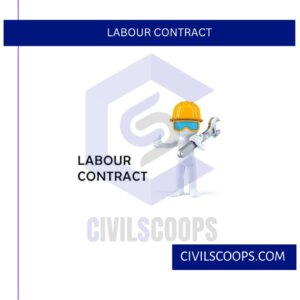All About Construction Contract

Table of Contents
What Is Construction Contract?

Contract, especially when we talk about types of contract in construction and types of contracts in civil engineering, as per the Indian Contract Act 1872 means’agreements that are enforceable as such having been made with the free consent of the parties, by persons competent to contract for a lawful consideration and lawful object and which are not expressly declared to be void by any statute.’
In the definition, we could infer the criteria required for a contract to be valid.
These criteria are:
- There must be a mutual agreement between the two parties.
- There must be an offer made by one party called the promisor.
- The other party, called the promisee, must accept the offer.
- There must be a consideration, which is usually payment in the form of money for doing an act or abstinence from doing a particular act by promisor for promisee.
- The offer and acceptance should relate to something that is not prohibited by law.
- The offer and acceptance constitute an agreement that, when enforceable by law, becomes a contract.
- The contracting parties entering into the agreement should be competent, i.e., not disqualify
- Fied by either infancy or insanity to make such an agreement.
List of Contract Document
A conctruction contract comprises the following documents essentially:
- The Contract Drawing
- The Specifications
- The General Conditions of Contract (GCC)
- The Special Conditions of Contract (SCC)
- The Agreement
- The Bill of Quantities (BOQ)
Note: The turnkey tender documents may be having only the preliminary drawing may not have the bill of quantities
Categories of Contract
1. Separated Contracts
- Lump-Sum Contracts
- Measurement Contracts
- Item Rate Contracts
- Percentage Rate Contracts
- Cost Plus Percentage Contracts
2. Management Contracts
- Management Contracts
- Conctruction Management Contracts
- Design Management and Conctruction Contracts
3. Integrated Contracts
- Design-build Contracts
- Turkey Contracts
- Build Operate and Transfer
4. Discretionary Contracts
- Partnering Contracts
- Joint Venture Contracts
Also Read: Information About Contractor
Useful Article for You
- What Is a Highway Flyover
- What Is Grouting
- What Is a Pile Cap
- What Is a Bond Beam in Masonry
- What Is Sapwood
- What Is Crane
- What Is a Gable
- What Is Superelevation
- What Is Kerb
- What Is the Purpose of Washers
- What Is the Size of a Brick in Inches
- What Is Reinforced Masonry
- What Is Workability
- What Is Bond Breaker
- What Is Plasticizer in Concrete
- What Is Luminous Flux Vs Lumens
- What Is Caisson
- What Is an Undercoat
- What Is a Benchmark Surveying
- What Is Bracing in Construction
- What Is a Beam in Construction
- What Is the Standard Door Frame Size
- What Is a Spandrel Beam
- What Is a Weep Hole
- What Is Tie Beam
- What Is Fine Aggregate
- What Is Pony Wall
- What Is Flag Stone
- What Is Development Length
- What Is Cement Plaster
- What Is a Pitched Roof
- What Is a Slab in Construction
- What Is a Monolithic Slab
- What Is Linear Distance
- What Is Shovel
- What Is Lintel in Construction
- What Is a Concept Sketch
- What Is Mezzanine Floor
- What Is Man Sand
- What Is Plaster Made Out of
- What Is a Floating Slab
- What Is Falsework
- What Is Bituminous
- What Is a Spillway
- What Is Curb and Gutter
- What Is Dampness
- What Is Lap Length
- What Is the Full Form of Fsi
- What Is Door Frame
- What Is Plinth Protection
- What Is Traffic Rotary
- What Is Grade Slab
- What Is Rolling Margin of Steel
- What Is Modulus of Rupture
- What Is Fresh Concrete
- What Is Dpc in Construction
- What Is Earthen Dam
- What Is Plum Concrete
- What Is Shell Structure.
- What Is Lumber
- What Is the Strongest Foundation for a House
- What Is the Meaning of Soundness of Cement
- What Is Flyover Bridge
- What Is Under Reamed Pile
- What Is Weir
- What Is Inverted Beam
- What Are the Advantages of Levelling?
- What Is Sunk Slab
- What Is Brick Bat Coba
- What Is Isolated Footing
- What Is Long Column
- What Is Plate Load Test
- What Is Formwork
- What Is Concealed Beam
- What Is Acp
- What Is Wbm Road
- What Is Slab
- What Is Quick Setting Cement
- What Is Rapid Hardening Cement
- What Is Perennial Canal
- What Is Wpc Board
- What Is Grade of Cement
- What Is Culvert Bridge
- What Is Ferrocement
- What Is Mortar in Construction
- What Is Floating House
- What Is Combined Footing
Types of Engineering Contracts

When considering types of contract costing and types of contracts in law, following are the different types of engineering contracts:
- Lump-Sum Contract
- Item-Rate & Unit Price Contract
- Percentage-Rate Contract
- Cost Plus Percentage Contract
- Cost Plus Fixed Fee Contract
- Cost Plus Variable Percentage Contract
- Labour Contract
- Target Contract
- Negotiated Contract
1. Lump-Sum Contract

Nature of Agreement In case of a lump-sum contract, the contractor agrees to carry out the entire work as shown in the drawings and described by specifications, by supplying labour and materials, all for a specified lump-sump.
Sometimes, the agreement makes a provision for adjusting the “fixed sum,” allowing for the cost of extras, variations, omissions, etc.
The major feature of the agreement is that the contractor agrees to accomplish all his/her contractual obligations and responsibilities for the stipulated payment, no matter what trouble or expense he/she comes across or incurs in doing so.
All the documents, except the “bill of quantities,” form the basis of the agreement.
A schedule of rates is sometimes included to work out the cost of extras or omissions.
Also Read: Concrete Material Calculation / Concrete Quantity
2. Item-Rate & Unit Price Contract

Nature of Agreement What is an item rate contract? An item-rate contract is one in which the contractor agrees to carry out the work as per the drawings, bills of quantities, and specifications in consideration of a payment to be made entirely on measurements taken as the work proceeds, and at the unit-prices tendered by the contractor in the bill of quantities.
This method has its own item rate contract advantages and disadvantages.
A bill of quantities is prepared, giving, as precisely as possible, the quantities of each item of work to be carried out, and the contractor enters the unit rate against each item of work.
The basis of the agreement is thus the unit rate of each item, certain practical and reason-able variations in the quantities being accepted by both parties.
All the documents are invariably included in the agreement.
For example,
The bill of quantities includes an item of cement concrete, and the estimated quantity is 11,000 m3.
The contractor’s tendered rate represents the amount that he/she is to be paid for each cubic meter of concrete in the finished work,
Whether the actual quantity is 10,000 m3 or 12,000 m3.
3. Percentage-Rate Contract

In this form of the contract, often referred to as difference between item rate contract and percentage rate contract, the department draws up the schedule of items according to the description of items sanctioned in the estimate with the quantities, units, rates, and amounts shown therein.
When a department fixes the rate of item it is known as “Item Rate Contract”.
The percentage-rate contract is similar to the item-rate contract in almost all respects except for the method of tendering the unit rates.
The bills of quantities supplied to all the intending bidders include, in addition to the approximate quantities and detailed description, the unit rates as estimated by the engineer.
While tendering, the contractors do not have to write the rate or estimated cost of each item, but a percentage figure by which the estimate unit rates are to be increased or decreased, the same percentage figure being applicable to all the items.
Contract documents are the same as those included in an item-rate contract.
At the time of making the payments to the contractor, the engineer works out the cost of the work done in a manner similar to an item-rate contract by multiplying the quantities by the rate in the bill of quantities.
But increases or decreases the final amount by the percentage figure above or below quoted by the contractor, respectively.
Also Read: Concrete Construction Tools for Construction Sites
4. Cost Plus Percentage Contract

It is seen while discussing the above common forms of contracts that neither party is sure of the final cost of the project as will be built till the completion of the project.
In these days of increase price rise, especially when considering different types of contracts, and absence of a satisfactory explanation to determine and pay escalation in the cost on a mutually agreed basis, contracting can be reduced to gambling or betting.
If the contractor is likely to lose heavily, he/she abandons the work midway to the detriment of the employer.
If the employer has to pay in excess of the agreed contract sum, he/she runs the risk of financial difficulty.
An alternative form of a contract, which does not throw much risk on either party, is the cost-plus type contract.
5. Cost Plus Fixed Fee Contract

The cost plus fixed fee contract differs from the cost-plus percentage type contract with respect to the determination of the fee to be paid to the contractor to cover overheads and profit.
The agreement specifies the fixed lump-sump to be paid to the contractor by the owner over and above the actual cost of the work.
In other words, the fee does not fluctuate with the actual cost of the work. This factor overcomes the possible weaknesses of the cost plus percentage type of contract.
However, in this case, there is no incentive for the contractor to do the work efficiently and to affect the economy in the cost of construction of the work.
If the fixed fee is to include the salaries of the contractor’s staff, the contractor will try to complete the work as speedily as possible to make maximum profit.
Even if the salaries of his/her staff are to be classified as part of the general costs of the work, he/she will try to expedite the project so that his/her men can be available for another contract to make an additional profit therefrom.
In respect of all other points, this form of contract is similar to the cost-plus percentage type contract.
Useful Article for You
- How Wide Is a Cinder Block
- How Much Is a Coffered Ceiling
- How to Make Mortar
- How Long Does Hempcrete Last
- How to Use a Hand Sight Level
- How to Build a Lean to Roof
- How Are Tunnels Built
- How to Layout a Building
- How Wide Is a Car Parking Space
- How Do Shear Walls Work
- How to Measure Concrete Slump
- How to Use Washers with Screws
- How Dense Is Sand
- How High Is a Window from the Floor
- How Does a Beam Bridge Work
- How Do They Pour Concrete Under Water
- How Does a Sewer System Work
- How High Are Countertops
- How to Seal Brick Wall Interior
- How to Resurface Cement
- How to Use Portland Cement
- How Is Plaster Made
- How Many Types of Slope Are There
- How Big Is a Stair Landing
- How to Get Paint Off Concrete Without Chemicals
- How to Fix Water Damaged Drywall
- How Much to Get Septic Pumped
- How to Cut a Nail or Screw
- How Long Does Wet Concrete Take to Dry
- How Is Varnish Made
- How Does Ejector Pump Work
- How Does Hydrometer Work
- How to Get Wet Blood Out of Carpet
- How to Build House on Slope
- How Thick Is Plaster Wall
- How Suspension Bridges Work
- How to Seal a Concrete Roof
- How Was Cement Invented
- How to Calculate Area of Steel
- How to Check Silt Content in Sand
- How a Building Is Constructed
- How Are Roads Classified in India
- How Many Types of Cement in India
- How to Find Contour Interval
- How Hardness of Brick Is Tested
- How Many Types of Paint Brushes Are There
- How to Calculate Skirting Area
- How Many Types of Beam
- How Many Types of Chain in Surveying
- How to Find One Way and Two Way Slab
- How Many Types of Houses
- How to Find Steel Bar Weight
- How to Calculate Septic Tank Capacity in Liters
- How to Calculate the Bearing Capacity of Soil
- How Many Types of Bricks Are There
- How Many Types of Cement Are There
- How to Make Block
- How Many Types of Bridge
- How Much Sand Required for 1 Sq.feet Area
- How to Texture Walls with Paint
- How Many Type of Beam
- How Is Tar Made
- How to Stop Water Leakage from Terrace
- 1cum How Many Bricks
- How to Calculate Shear Force and Bending Moment
- How to Building
- How to Calculate Fineness Modulus
6. Cost Plus Variable Percentage Contract

By introducing an element of incentive for the contractor to carry out the work in the most economical way, an attempt is made in this form of contract to overcome the main drawbacks of the previous two types of cost-plus contracts.
This is achieved by suitably changing the nature of the agreement in respect of the fee payable to the contractor.
The amount of fee is determined by reference to some form of a sliding scale.
Thus, the higher the actual cost, the lower is the value of the fee that the contractor receives and vice versa.
From the owner’s point of view, this is one of the best “cost-plus” type contracts.
The developed form of this contract is the target contract.
7. Labour Contract

The special feature of a labour contract is that the owner agrees to supply all the required materials to the contractor, and the latter agrees to supply all the labour and workmanship necessary to complete the work according to the drawings and specifications.
This form of contract is suitable for those cases where the owner is in a position to buy large quantities of materials at favorable rates and also deliver them to the site of work most economically.
For example, spreading and compacting metal and laying and fixing sleepers on the railway track.
Also Read: First Angle Projection & Third Angle Projection Symbol (Orthographic Projection)
8. Target Contract

This form of contract is comparatively of recent origin.
It combines the best features of the cost plus percentage and the cost-plus fluctuating fee type contracts.
The contractor is paid on a cost-plus percentage basis for work performed under the contract plus or minus a certain amount, which is an agreed percentage of savings or excess affected against the target value.
The target value is arrived at by measuring the work on completion and valuing it at the rates agreed to earlier.
9. Negotiated Contract

The negotiated contract is a case where the contract is awarded on the basis of a direct agreement with a contractor, by not going through the process of competitive bidding.
It is otherwise called negotiated agreement.
Hence, a negotiated contract is a kind of agreement where a specific firm is targeted, for a variety of causes, to carry out the contract, although there is more than one firm that can carry out the contract.
Under usual conditions, a competitive tender or proposal would be issued.
This differs from an exclusive source situation, which takes place when: there is only one firm that is available and capable of carrying out and completing the contract, and/or the urgency of the situation dictates that the competitive procedure cannot be used.
A contract is a legally binding agreement between two or more parties to uphold terms in a relationship, as set forth by the contract.
The negotiated contract entails the process of discussing and compromising on contract terms and conditions in order to reach the final, approved draft of a contract.
Some contracts are non-negotiable, in cases with leases and warranties extended by the manufacturers.
However, there are contracts business, real estate development, and finances that are negotiated in order to reach terms that are satisfactory to all parties involved.
[su_box title=”FAQ” style=”default” box_color=”#333333″ title_color=”#FFFFFF” radius=”3″ class=”” id=””]
What Is Construction Contract?
In simple terms, construction contracts are legally binding agreements that explain the work to be performed by a general contractor and the payment that will be made by a project owner.
What Does a General Contractor Do?
Traditional contractors oversee the implementation of design plans that have been put together by someone else, typically an architect or engineer. Design-build contractors provide a complete package by working with the client to plan and implement the entire project.
Types of Engineering Contracts
- Lump sum contract
- Cost-plus contract
- Percentage rate contract
- Material supply contract
- Target contract
- Labour contract
Unit Price Contract in Construction
In a unit price contract, a construction company prices individual portions, or units, of work to estimate a total project cost. Each unit is based on several variables, in combination or on their own, such as materials, labor and overhead. If the scope of a project changes along the way, units can be added or removed.
What Is a Contract Rate?
A contract rate is a fixed price and volume commitment for a set lane over a set period of time, usually one year. Once you agree to a rate, you are better able to forecast your spend and are less subject to market fluctuations as you have an agreed-to price.
What Are the 7 Elements of a Valid Contract?
Contracts constantly vary in length, terms, and complexity. But for an agreement to be legally valid and enforceable, several elements must be fulfilled: Legality, Capacity, Offer, Consideration, Intention, Certainty, and Acceptance.
Lump Sum Contract
A lump sum contract, sometimes called stipulated sum, is the most basic form of agreement between a contractor and a customer. A lump sum contract or a stipulated sum contract will require that the contractor agree to provide specified services for a stipulated or fixed price.
Unit Price Contracts
A Unit Price Contract allows projects to be broken down into and priced by units as opposed to a fixed cost. The flexibility of this contract is something that can’t be found in others like a Fixed Cost or Lump Sum Contract. This is an extremely attractive option but only for the right project.
What Are the 4 Types of Contracts?
4 Different Types of Contracts
- Sales Agreements.
- Non-Disclosure Agreements and Intellectual Property Management.
- Professional Service Agreements – Fixed-Price, Time and Materials, and Retainer-Based Contracts.
- Adhesion Contracts.
What Are the 3 Types of Contracts?
Some of the most popular contracts include fixed-price contracts, cost-plus contracts, and time and materials contracts. While you can use software and other tools to help you generate professional agreements, you should still understand the basics of different types of contracts as a business owner.
Cost Plus Percentage Contract
A CPPC contract is one that is structured to pay the contractor his actual costs incurred on the contract plus a fixed percent for profit or overhead (that is not audited/adjusted) and which is applied to actual costs incurred.
What Are the Main Types of Construction Contracts?
The 5 Key Types of Construction Contracts
- Lump sum contracts.
- Time and materials contracts.
- Unit price contracts.
- Guaranteed maximum price (GMP) contracts.
- Cost-plus contracts.
What Are the Three Most Commonly Used Types of Construction Contracts?
- Fixed Price. The most common type of contract is the fixed price contract, also known as the lump sum or stipulated sum contract.
- Cost-Plus Fee.
- Unit Price.
Negotiated Contract
Contract negotiation is the process through which two or more parties deliberate over the terms of a contract to reach an agreement on how their relationship will operate and what their obligations will be.
Target Contract
In a target price contract, the parties negotiate the target price, which is the amount expected to complete the scope of work. If the final invoice amount is less than the target, the parties split the savings according to a pre-negotiated ratio. This is the incentive.
Labour Contract
An agreement between two parties: one party, the employee, agrees to work for the other party, the employer, for a weekly number of hours in return for a wage. A distinction is made between a labour contract for a fixed period of time and an open-ended labour contract.
Cost Plus Variable Percentage Contract
Cost plus percentage contracts are invoices that charges the cost of the materials plus a percentage of the total materials used. These are typically used for custom work and where the amount of materials needed is not readily estimated.
Cost Plus Fixed Fee Contract
A cost-plus-fixed-fee contract is a cost-reimbursement contract that provides for payment to the contractor of a negotiated fee that is fixed at the inception of the contract. The fixed fee does not vary with actual cost, but may be adjusted as a result of changes in the work to be performed under the contract.
Percentage Rate Contract
Percentage rate contract: Refers to a type of item rate contract. In a percentage rate contract, all the sanctioned items are drawn up according to their descriptions with amounts, quantities, rates, and units as shown in the estimate.
[/su_box]
[su_note note_color=”#F2F2F2 ” text_color=”#333333″ radius=”3″ class=”” id=””]
Like this post? Share it with your friends!
Suggested Read –
- What Is Staircase
- Civil Engineering Software
- West Point Bridge Designer
- What Is Water Cement Ratio
- Difference Between Lap Length and Development Length
[/su_note]
Originally posted 2023-11-28 10:06:25.
